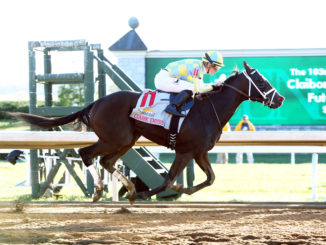
words & photos by Teresa Genaro
In 2013, the year before the Star and Stripes Festival was inaugurated at Belmont Park, the 4th of July weekend card was highlighted by the Grade 2 Suburban and the Grade 2 Dwyer. Flat Out won the former, Moreno the latter. The combined stakes money available that day was $550,000, the Suburban offering a $350,000 purse. Attendance was 5,047; bettors wagered $1.8 million on-track and $11.9 million off-track. (Note: wagers made through NYRA’s ADW, then as now, are considered on-track wagers, no matter where they are placed.)
Five years later, the early July racing highlight bears little resemblance to its 2013 relative. Though called the Stars and Stripes Festival, it’s not necessarily pegged to Independence Day, last year and this falling on the weekend following the holiday. It now boasts five graded stakes races worth $3.7-million; the Dwyer purse has doubled to $400,000 despite being downgraded to a Grade 3; the Suburban is now worth $750,000.
Three races have been added to the day: the Belmont Sprint Championship (G2, $350,000), which began as the James Marvin at Saratoga in 2008; the Belmont Oaks Invitational (G1, $ 1 million), formerly known as the Garden City and run during the Belmont fall meet; and the Belmont Derby Invitational (G1, $1.2 million), which was the Jamaica until 2014 and at Belmont in the fall.
The current NYRA administration worships at the altar of Big Event Racing; over the last few years, graded stakes have disappeared from many weekends on the racing calendar and on weekdays at Saratoga and been consolidated into a handful of blockbuster days, days on which the company can charge more for its simulcast signal and attract media attention. Saturday’s card was broadcast on the main NBC channel for 90 minutes, featuring the Dwyer, the Sprint Championship, and the Belmont Oaks.
Paid attendance was announced as 12,667, a number that included customers that attended after having received a free ticket to the day when they purchased Belmont Stakes tickets and that is more than double the attendance on the last pre-Stars and Stripes card. Handle on that 2013 card was 63% lower than it was on Saturday, even if Saturday’s handle dipped slightly from the previous year.
Of course, such numbers in isolation tell only a small part of the story; field size and weather conditions significantly affect handle, and a truer comparison would be of the overall numbers of the Belmont spring meet compared to past years, numbers that won’t be available, in terms of handle, until after closing day on this Sunday. As NYRA stopped releasing Belmont attendance figures several years ago, it’s impossible to tell how attendance has been affected by the shifting of most graded stakes races to Belmont Stakes Day and the Stars and Stripes Festival.
Undeniably, though, Saturday felt like an event at Belmont. Even if that 12,667 paid attendance seems a little high, the backyard, apron, and paddock were frequently full, and more than the usual number of media showed up for the day, including several out-of-town photographers.
 Conceived at least in part as way to attract European three-year-olds to two big-money turf stakes, the day seems like a mixed success in that regard at best. Over the last four years, only a few international turf horses have shown up each year for the Belmont Oaks and the Belmont Derby, and only one has won, Aidan O’Brien’s Deauville in the Belmont Derby last year. The Belmont Oaks may well at some point be named after Chad Brown, who has won five of the last six runnings of the race (going back to when it was the Garden City), and this year he saddled the trifecta. Whether the Stars and Stripes Festival (perhaps a curious name for a day designed to attract international competition) increases international interest in Belmont racing, or whether the presence of a few international horses increases interest in racing beyond these shores is debatable.
Conceived at least in part as way to attract European three-year-olds to two big-money turf stakes, the day seems like a mixed success in that regard at best. Over the last four years, only a few international turf horses have shown up each year for the Belmont Oaks and the Belmont Derby, and only one has won, Aidan O’Brien’s Deauville in the Belmont Derby last year. The Belmont Oaks may well at some point be named after Chad Brown, who has won five of the last six runnings of the race (going back to when it was the Garden City), and this year he saddled the trifecta. Whether the Stars and Stripes Festival (perhaps a curious name for a day designed to attract international competition) increases international interest in Belmont racing, or whether the presence of a few international horses increases interest in racing beyond these shores is debatable.
Comparisons to previous incarnations aside, the day provided no shortage of storylines to the casual and the dedicated racing fan. Practical Joke re-established himself as a horse to contend with (though perhaps not at classic distances) in the three-year-old division when he cruised to victory in the Dwyer, and his performance has Brown thinking Haskell.
Practical Joke takes the 100th running of the Dwyer pic.twitter.com/vEtpUR3aEE
— Teresa Genaro (@BklynBckstretch) July 8, 2017
Mind Your Biscuits continued his domination of the sprint division, notching another graded stakes win and becoming a multi-million-dollar earner.
 And then there was Keen Ice, 2015 Travers dispatcher of American Pharoah, who thrilled the approximately seven thousand Donegal Racing partners in attendance (see winner’s circle photo above) when he closed into a slow pace to get his second graded stakes win, and third overall. He joins a select club of only 10 horses to have won both the Travers and the Suburban. Next time someone asks you what Buckpasser, Easy Goer, and Keen Ice have in common, you’ll know.
And then there was Keen Ice, 2015 Travers dispatcher of American Pharoah, who thrilled the approximately seven thousand Donegal Racing partners in attendance (see winner’s circle photo above) when he closed into a slow pace to get his second graded stakes win, and third overall. He joins a select club of only 10 horses to have won both the Travers and the Suburban. Next time someone asks you what Buckpasser, Easy Goer, and Keen Ice have in common, you’ll know.
We’ll see next week how Belmont did overall this spring, and that will put Saturday’s card and the Festival strategy in a more useful perspective than simply looking at in isolation. But as a stand-alone day, it’s difficult to argue with the financial results, the buzz at Belmont, or the sense, from customers and owners, that last Saturday was something more than an ordinary day at the races.



